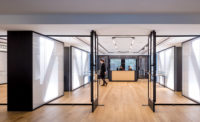Hachioji City, Japan
With its iconic arches, Toyo Ito’s new library at Tama Art University has the aura of a Romanesque building. But caves, not compression structures, were the architect’s inspiration, so any similarities to European antecedents are merely superficial. And unlike the straightforward, repetitive systems used historically, Ito’s high-tech concrete curves—each one different—tiptoe gracefully in multiple directions throughout the building.
The building marks the final stage in the development of the 45-year-old campus, one of two belonging to the multimedia art school where Ito serves as a guest professor. Located 16 miles west of central Tokyo, the hilly, 39-acre property abuts open land once earmarked for residential development but still fallow in 2007. Housed in a collection of concrete-and-glass buildings bound by tree-lined streets, the school enrolls 3,600 students who commute daily to its studio and performing arts facilities. Ito’s library commands a choice site overlooking the university’s main gate and the public bus stop beyond it. Defined on two sides by bowed walls, it makes a strong first impression: monumental without being a monument, and contextual in scale and material without getting lost in the shuffle.
To capitalize on the building’s strategic location, Ito first wanted to submerge the library and top it off with a single-story gathering place where students and professors could cross paths and exhibit their work. But this idea did not go over well with the university administration, which envisioned a conventional 3- or 4-story building with a gallery below. Also, buried infrastructure prevented a full-scale site excavation. Despite these roadblocks, Ito was unwilling to abandon his original concept altogether. So he inverted his underground grotto and turned it into a 60,700-square-foot building with a single, large space on each of its two stories, each one loosely divided into functional zones by arcades.
A continuous sheet of concrete, the building’s cavernous ground floor flows down to the north, following the land’s natural slope. It reads as a unified, slanting space accessed through an arcaded gallery. A circulation conduit and multipurpose exhibition hall all in one, this informal gallery has plenty of room for students to congregate around one of its built-in tables or display their work, be it a painting or a performance piece. It also acts as the entry foyer leading into the library, whose ground level contains the circulation desk, an administrative area, a media bar, and magazine display tables topped with glass that parallel the angled floor. A set of stairs shaped like a floating curlicue of concrete ascends to the second floor, where the main reading area flows into open stacks on one side and a two-story block of closed stacks on the other. Unlike downstairs, the floor plane here had to be level for the book trolleys that transport the library’s 10,000 volumes. But overhead, the ceiling tilts up gently, filling the entire second floor with soft, north light.
PeopleArchitect Design Team: Associate architect: Client: Engineer (structural): Consultants: General contractor: Shop drawing: Air conditioning, plumbing and mechanical services: Electrical installation: Form work:
|
ProductsSteel fabricator: Glazing: Access flooring: Carpet tiles: Custom lighting: Furniture fabrication: Air-return grilles: Curtain wall: Signage: |



Post a comment to this article
Report Abusive Comment